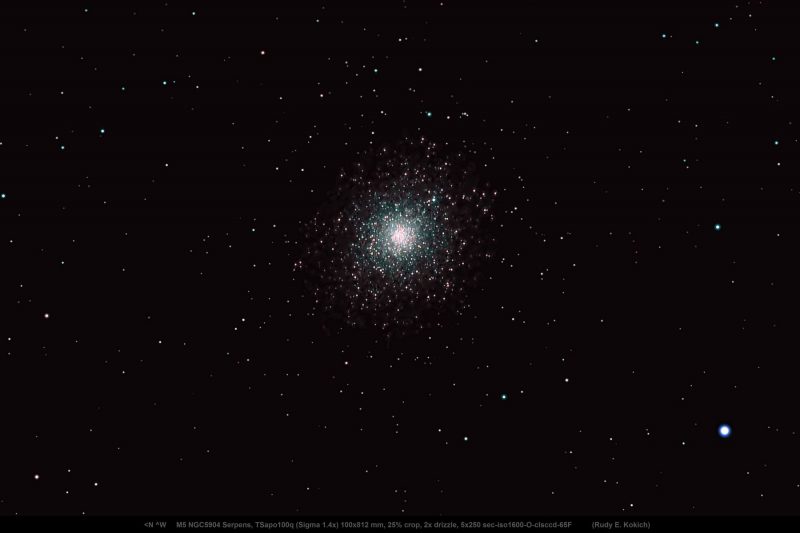
With your eye alone, binoculars, and a telescope, you can stairstep your way to the beauty of globular star cluster M5, or Messier 5. With the unaided eye, M5 is barely detectable with the appearance of a faint star. Binoculars show it a bit more clearly. But turn a small telescope on it, and you’ll see one of the finest globular clusters north of the celestial equator.
Unlike many of the “faint fuzzies” in the night sky – nebulas, galaxies and clusters that still appear as dim, blurry smudges even through telescopes – M5 is one of the best globular clusters to observe. Burnham’s Celestial Handbook says that Admiral Smyth called M5 a:
… Superb object … a noble mass, refreshing to the senses after searching for faint objects.
But you have to have a decent telescope for the best views. Otherwise, with your eye alone or binoculars, you might describe it as Charles Messier did:
… A fine nebula which I am sure contains no star.
In reality, hundreds of thousands of stars pack tightly into the globular cluster M5, including an unusual number of variable stars.
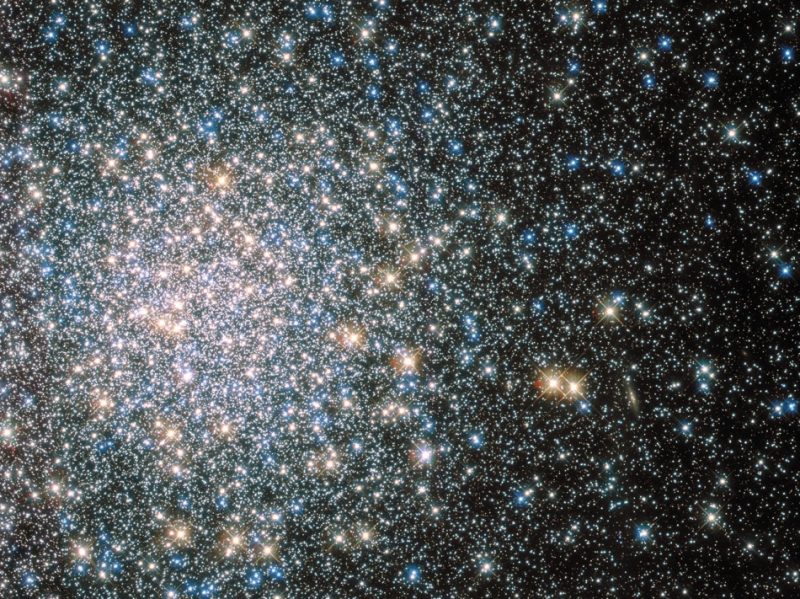
Globular clusters versus open clusters
Many of the brighter and larger clusters visible from Earth are open star clusters. For example, the Pleiades and the Hyades clusters are open star clusters. Open star clusters are born, and live out their lives, within the galactic disk. They are loose collections of several hundred stars. The ones we know best are relatively nearby, a few hundred light-years away.
In contrast, M5 is a globular star cluster. Globular clusters reside within the galactic halo – a sphere-shaped region of the Milky Way that extends above and below the galactic disk. If we liken the disk to a hamburger, then the bun would be the galactic halo. Globular star clusters contain hundreds of thousands of stars, tightly packed in a round ball.
Globular clusters are ancient
Globular clusters are our galaxy’s oldest members. In other words, they formed first, as the galaxy was forming. Spanning 165 light-years in diameter, M5 is one of the largest globular clusters known. It contains more than 100,000 stars, or as many as 500,000, according to some estimates.
The relatively young stars of open clusters disperse after hundreds of millions of years. The stars in globular clusters still remain closely associated after many billions of years.
As you gaze at M5, you’re looking at an object that’s around 13 billion years old, more than twice the age of our solar system, and almost as ancient as the universe itself. Considering that M5 lies some 25,000 light-years distant, we can only imagine what this stellar city would look like if it were at the Pleiades’ distance of 430 light-years. Or imagine what an inhabitant of a planet inside a globular cluster would see.
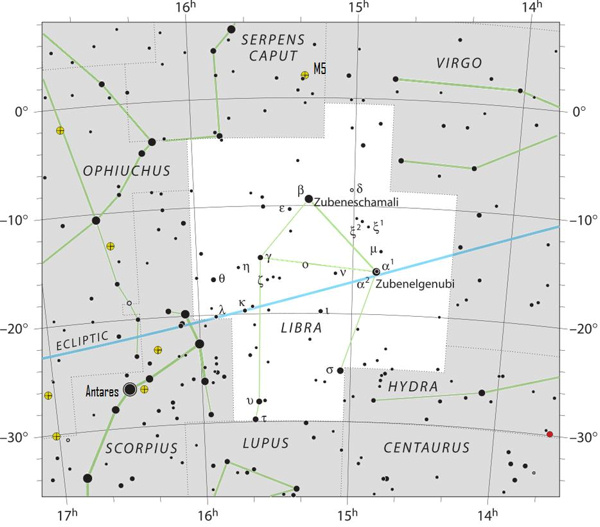
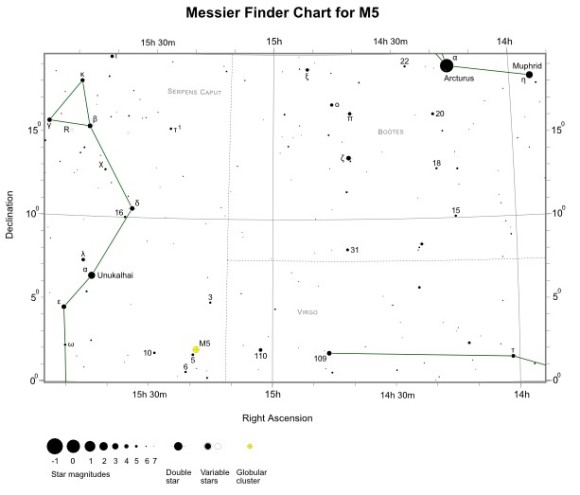
How to find M5
M5 is located in the constellation Serpens Caput (the Serpent’s Head). From the Northern Hemisphere, it’s above the southwestern horizon after it gets dark in mid-August. It sinks toward the west and sets after midnight directly to the west. Around September it’s gone by midnight.
Using a fist at arm’s length for a guide, M5 resides a good two fist-widths to the southeast of yellow-orange Arcturus, summertime’s brightest star. M5 is also three fist-widths to the east of blue-white Spica, the brightest star in the constellation Virgo.
Plus, M5 is about one fist-width to the north (above) Zubeneschamali. These stars give you at least a rough idea of M5’s whereabouts in the heavens.
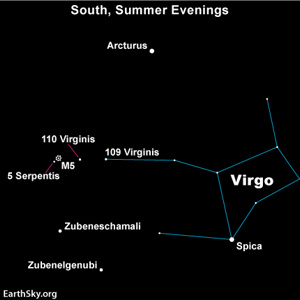
Practiced sky gazers star-hop to M5 by way of two faint yet visible Virgo stars: 109 Virginis and 110 Virginis. They draw an imaginary line from 109 Virginis through 110 Virginis, and go twice the distance to land on the star 5 Serpentis. M5 is only 1/3 of a degree to the northwest (upper right) of this star. The distance from 109 Virginis to M5 spans about 8 degrees of sky. For reference, the width of four fingers at arm’s length away approximates 8 degrees.
Variable stars in M5
Astronomers have found more than 100 variable stars in this globular cluster. Variable stars are those that vary in brightness over a period of time. Many of the stars are RR Lyrae variable stars, a type of star that pulses irregularly. A different type of variable star, a Cepheid variable, is bright and pulses regularly, making them helpful tools for astronomers to determine distances. Scientists have also found Cepheid variables in the cluster. In addition, one SS Cygni class variable, or dwarf nova, a faint eruptive star, also lies in M5.
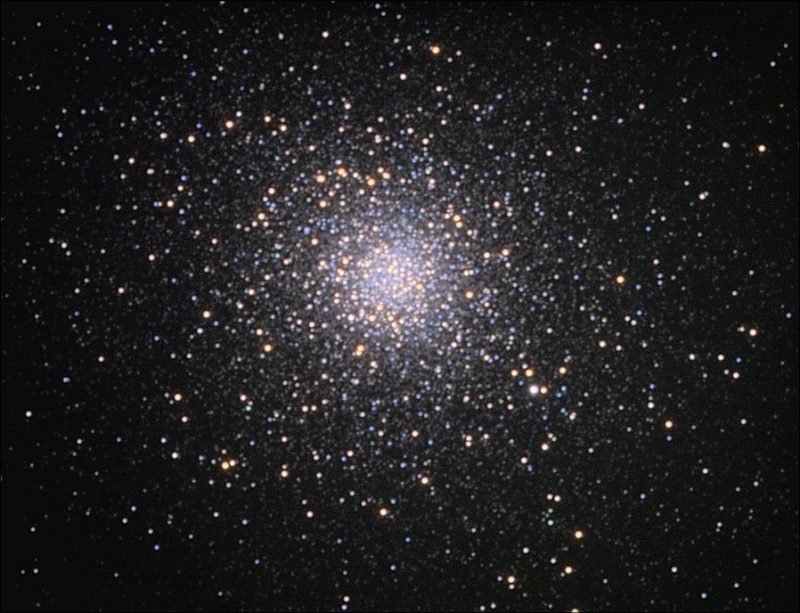
Bottom line: M5 is a wonderful globular cluster in Serpens Caput to explore with a small telescope.
The post M5, your new favorite globular star cluster first appeared on EarthSky.
from EarthSky https://ift.tt/3g5as7o

With your eye alone, binoculars, and a telescope, you can stairstep your way to the beauty of globular star cluster M5, or Messier 5. With the unaided eye, M5 is barely detectable with the appearance of a faint star. Binoculars show it a bit more clearly. But turn a small telescope on it, and you’ll see one of the finest globular clusters north of the celestial equator.
Unlike many of the “faint fuzzies” in the night sky – nebulas, galaxies and clusters that still appear as dim, blurry smudges even through telescopes – M5 is one of the best globular clusters to observe. Burnham’s Celestial Handbook says that Admiral Smyth called M5 a:
… Superb object … a noble mass, refreshing to the senses after searching for faint objects.
But you have to have a decent telescope for the best views. Otherwise, with your eye alone or binoculars, you might describe it as Charles Messier did:
… A fine nebula which I am sure contains no star.
In reality, hundreds of thousands of stars pack tightly into the globular cluster M5, including an unusual number of variable stars.

Globular clusters versus open clusters
Many of the brighter and larger clusters visible from Earth are open star clusters. For example, the Pleiades and the Hyades clusters are open star clusters. Open star clusters are born, and live out their lives, within the galactic disk. They are loose collections of several hundred stars. The ones we know best are relatively nearby, a few hundred light-years away.
In contrast, M5 is a globular star cluster. Globular clusters reside within the galactic halo – a sphere-shaped region of the Milky Way that extends above and below the galactic disk. If we liken the disk to a hamburger, then the bun would be the galactic halo. Globular star clusters contain hundreds of thousands of stars, tightly packed in a round ball.
Globular clusters are ancient
Globular clusters are our galaxy’s oldest members. In other words, they formed first, as the galaxy was forming. Spanning 165 light-years in diameter, M5 is one of the largest globular clusters known. It contains more than 100,000 stars, or as many as 500,000, according to some estimates.
The relatively young stars of open clusters disperse after hundreds of millions of years. The stars in globular clusters still remain closely associated after many billions of years.
As you gaze at M5, you’re looking at an object that’s around 13 billion years old, more than twice the age of our solar system, and almost as ancient as the universe itself. Considering that M5 lies some 25,000 light-years distant, we can only imagine what this stellar city would look like if it were at the Pleiades’ distance of 430 light-years. Or imagine what an inhabitant of a planet inside a globular cluster would see.


How to find M5
M5 is located in the constellation Serpens Caput (the Serpent’s Head). From the Northern Hemisphere, it’s above the southwestern horizon after it gets dark in mid-August. It sinks toward the west and sets after midnight directly to the west. Around September it’s gone by midnight.
Using a fist at arm’s length for a guide, M5 resides a good two fist-widths to the southeast of yellow-orange Arcturus, summertime’s brightest star. M5 is also three fist-widths to the east of blue-white Spica, the brightest star in the constellation Virgo.
Plus, M5 is about one fist-width to the north (above) Zubeneschamali. These stars give you at least a rough idea of M5’s whereabouts in the heavens.

Practiced sky gazers star-hop to M5 by way of two faint yet visible Virgo stars: 109 Virginis and 110 Virginis. They draw an imaginary line from 109 Virginis through 110 Virginis, and go twice the distance to land on the star 5 Serpentis. M5 is only 1/3 of a degree to the northwest (upper right) of this star. The distance from 109 Virginis to M5 spans about 8 degrees of sky. For reference, the width of four fingers at arm’s length away approximates 8 degrees.
Variable stars in M5
Astronomers have found more than 100 variable stars in this globular cluster. Variable stars are those that vary in brightness over a period of time. Many of the stars are RR Lyrae variable stars, a type of star that pulses irregularly. A different type of variable star, a Cepheid variable, is bright and pulses regularly, making them helpful tools for astronomers to determine distances. Scientists have also found Cepheid variables in the cluster. In addition, one SS Cygni class variable, or dwarf nova, a faint eruptive star, also lies in M5.

Bottom line: M5 is a wonderful globular cluster in Serpens Caput to explore with a small telescope.
The post M5, your new favorite globular star cluster first appeared on EarthSky.
from EarthSky https://ift.tt/3g5as7o

Aucun commentaire:
Enregistrer un commentaire